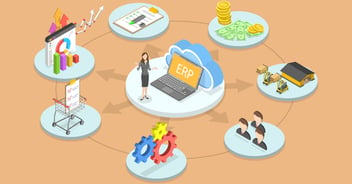
The famous Ford Pinto Case is a renowned illustration of how an organization can get muddled up in Cost Benefit analysis. The costs due to Ford Pinto design flaw was about $49.5 million, ie. based on probable accident rate. This was much less than the cost of issuing a recall which was $137.5M Hence Ford decided not to recall the cars according to the CBA. Ford overlooked the costs of negative publicity and eventually had to anyway recall the cars. The CBA by Ford was the decision that was better and cheaper for Ford only.
A fundamental issue here is on whose behalf the cost benefit analysis is being completed. Decision makers are rationally self-interested. Are you also considering your employees, your organizational culture, the geography of the organization and other socio-demographic aspects?
A few aspects to be considered while making CBA in ERP are Fitment, Implementation duration, Costs, Flexibility, Usability and Socio-Cultural issues alignment to best practices along with Executive Satisfaction, Employee satisfaction.
Lower costs – Although, cost is an important factor, it should not be a determining factor. The software’s ability to meet your need comes first. Do not mix up the must-haves with the nice-to-haves.
SMAC – Look at if the ERP is Social, Mobile, Analytic and Cloud oriented.
The Social Aspect – Executive Satisfaction and Employee Satisfaction are two important facets and should be considered while making an ERP selection and should be certainly achieved. During an ERP implementation life cycle, employees are asked to contribute to the organizational change and hence evolve in relation with this change. An organization may have irate and demotivated employees because of a decision of having a cheaper and faster implementation of an ERP. The perceived resource planning software may over-consume the employees’ bandwidth in terms of planning itself and is now alleged as a data entry and reporting software only rather than a resource planning software.
In general while performing a CBA, one should always choose the option where benefits outweighs cost, ceteris paribus, all other things held constant. For organizations, there needs to be a structured way of selecting an ERP based on a complete business case and ROI study. For choosing an ERP, it is important to consider the existing customers in your space and the best of breed vs cost, what an informed ERP buyer should look for when selecting a new solution, and the potential consequences of a poor ERP choice..
Here’s a quick CBA for selecting an ERP, based on numbers obtained through a research.
Option 2 looks lucrative with:
- High Market share
- Medium Duration
- Lower Cost (although unpredictable)
- Medium benefits realization
- High satisfaction
- Low business risk
Performing CBA is a daunting tasks when it comes to making good choices. CBA are of two paradigm - Financial and Economic/Social. A third paradigm around CBA is conceiving CBA in the public interest. Hence, It must demonstrate the stakeholders benefit. It is not just about doing things cheaper and better.
Integrating Change Management with ERP Solutions for Sustainable Success
A critical yet often underestimated dimension in Cost Benefit Analysis (CBA) of ERP solutions is the integration of effective change management strategies alongside the deployment of these systems. While selecting ERP services, organizations must go beyond cost and functionality considerations and focus on how the change impacts the workforce, workflows, and organizational culture over the long term.
ERP implementations frequently trigger significant process realignments that demand user adaptation and engagement. Without structured change management, resistance can manifest, eroding the anticipated benefits of the ERP investment. Incorporating comprehensive training programs, stakeholder communication plans, and continuous feedback loops within ERP services ensures smoother transitions and higher adoption rates.
Moreover, an ERP’s technical capabilities alone do not guarantee success; the human element is pivotal. Executive sponsorship and employee involvement throughout the implementation lifecycle directly correlate with improved satisfaction and operational efficiency. This alignment helps avoid scenarios where the ERP is perceived merely as a data-entry or reporting tool rather than a robust resource planning platform.
From an expert perspective, the CBA for ERP solutions should explicitly quantify the costs and benefits associated with change management initiatives. These include the reduction in productivity dips, enhanced user competence, and the long-term scalability of the ERP system. Evaluating these factors alongside traditional financial metrics provides a more holistic understanding of the ERP's true value proposition.
In essence, successful ERP adoption hinges on a balanced approach combining the right technology with a well-executed change management framework. This integrated view helps enterprises not only achieve immediate ROI but also build resilient operational capabilities adaptable to future business challenges.
Frequently Asked Questions (FAQs)
Enterprise asset management (EAM) involves the management of mission critical assets of an organization throughout each asset's lifecycle. EAM is used to plan, optimize, execute, and track the needed maintenance activities with the associated priorities, skills, materials, tools, and information. The aim is to optimize the quality and utilization of assets throughout their lifecycle, increase productive uptime and reduce operational costs.
Enterprise asset management (EAM) involves the management of the maintenance of physical assets of an organization throughout each asset's lifecycle. EAM is used to plan, optimize, execute, and track the needed maintenance activities with the associated priorities, skills, materials, tools, and information.
The software helps in effective maintenance of assets through preventive, predictive, shutdown and breakdown maintenance strategies. The system also helps enterprises mitigate equipment risks by enhanced safety standards. The streamlined operations and improved asset performance helps organizations increase their investment effectiveness.
EAM is important because it helps organizations track, assess, manage and optimize asset quality and reliability. Asset intensive Organizations have hundreds, thousands, even millions of assets which needs to be maintained to maximize / optimize life of these assets to increase the return on investment.
The key features of effective EAM are:
- Work management.
- Maintenance Strategies (Preventive/ Predictive / Breakdown / Shutdown).
- Planning and scheduling.
- Supply chain management.
- Health and safety.
- Mobility.
- Analytics.
- Improved Asset Health at reduced cost through data driven maintenance Programs
- Complete visibilityon entire maintenance data across Equipment, across Models, across Branches to aid in analysis & decision making such as to Repair or Replace the Equipment
- Insightful analysis of Inspection Data to improve customer satisfaction
- Effective maintenance management enhanced by predictive maintenance and inbuilt analytics
- Increased reliability and safety, keeps complete track of all the inspections & calibration schedules
- Mobile Application enables users to execute work while “in the field” leading to minimized non-productive time and increased productivity and reduces duplication of work and human errors in recording information.
- Quick turnaround time through Actionable Notification & Alerts for every process in real time and accessible anytime and anywhere.
- Improved Regulatory Part of asset management involves the implementation of better O&M practices, which can significantly improve compliance.
Asset Intensive companies under the following Industries :
- Ports
- Cement and Mining
- Utilities
- Fleet Maintenance
- Equipment Rental
- Other Manufacturing
- Real Estate & Infrastructure
- Power Generation
Contact us for a meeting and schedule a demo
This differs on case to case basis, based on the type of installation and unique industry specific requirements. Contact us for a meeting and schedule a demo.
This differs on case to case basis, based on the type of installation and unique industry specific requirements. Contact us for a meeting and schedule a demo.
Stay Connected, follow us on LinkedIn / Twitter to know more about EAM Software latest trends.


